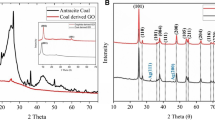Abstract
A new type of Au/TiO2/reduced graphene oxide (RGO) nanocomposite was fabricated by the hydrothermal synthesis of TiO2 on graphene oxide followed by the photodeposition of Au nanoparticles. Transmission electron microscopy images showed that Au nanoparticles were loaded onto the surface of both TiO2 and RGO. Au/TiO2/RGO had a better photocatalytic activity than Au/ TiO2 for the degradation of phenol. Electrochemical measurements indicated that Au/TiO2/RGO had an improved charge transfer capability. Meanwhile, chemiluminescent analysis and electron spin resonance spectroscopy revealed that Au/TiO2/RGO displayed high production of hydrogen peroxide and hydroxyl radicals in the photocatalytic process. This high photocatalytic performance was achieved via the addition of RGO in Au/TiO2/RGO, where RGO served not only as a catalyst support to provide more sites for the deposition of Au nanoparticles but also as a collector to accept electrons from TiO2 to effectively reduce photogenerated charge recombination.

Similar content being viewed by others
References
Hoffmann M R, Martin S T, Choi W, Bahnemannt D W. Environmental applications of semiconductor photocatalysis. Chemical Reviews, 1995, 95(1): 69–96
Nakata K, Fujishima A. TiO2 photocatalysis: design and applications. Journal of Photochemistry and Photobiology C: Photochemistry Reviews, 2012, 13(3): 169–189
Wang H, Quan X, Yu H T, Chen S. Fabrication of a TiO2/carbon nanowall heterojunction and its photocatalytic ability. Carbon, 2008, 46(8): 1126–1132
Hashimoto K, Irie H, Fujishima A. TiO2 photocatalysis: a historical overview and future prospects. Japanese Journal of Applied Physics, 2005, 44(12): 8269–8285
Mor G K, Shankar K, Paulose M, Varghese O K, Grimes C A. Use of highly-ordered TiO2 nanotube arrays in dye-sensitized solar cells. Nano Letters, 2006, 6(2): 215–218
Ge M, Guo C, Zhu X, Ma L, Han Z, Hu W, Wang Y. Photocatalytic degradation of methyl orange using ZnO/TiO2 composites. Frontiers of Environmental Science & Engineering, 2009, 3(3): 271–280
Wang S, Wang K, Jehng J, Liu L. Preparation of TiO2/MCM-41 by plasma enhanced chemical vapor deposition method and its photocatalytic activity. Frontiers of Environmental Science & Engineering, 2012, 6(3): 304–312
Tian Y, Tatsuma T. Mechanisms and applications of plasmoninduced charge separation at TiO2 films loaded with gold nanoparticles. Journal of the American Chemical Society, 2005, 127(20): 7632–7637
Méndez-Medrano MG, Kowalska E, Lehoux A, Herissan A, Ohtani B, Rau S, Colbeau-Justin C, Rodríguez-López J L, Remita H. Surface modification of TiO2 with Au nanoclusters for efficient water treatment and hydrogen generation under visible light. Journal of Physical Chemistry C, 2016, 120(43): 25010–25022
Golabiewska A, Malankowska A, Jarek M, Lisowski W, Nowaczyk G, Jurga S, Zaleska-Medynska A. The effect of gold shape and size on the properties and visible light-induced photoactivity of Au-TiO2. Applied Catalysis B: Environmental, 2016, 196: 27–40
Stankovich S, Dikin D A, Dommett G H B, Kohlhaas K M, Zimney E J, Stach E A, Piner R D, Nguyen S T, Ruoff R S. Graphene-based composite materials. Nature, 2006, 442(7100): 282–286
Perreault F, Fonseca de Faria A, Elimelech M. Environmental applications of graphene-based nanomaterials. Chemical Society Reviews, 2015, 44(16): 5861–5896
Zhang N, Yang M Q, Liu S, Sun Y, Xu Y J. Waltzing with the versatile platform of graphene to synthesize composite photocatalysts. Chemical Reviews, 2015, 115(18): 10307–10377
Zhang H, Lv X, Li Y, Wang Y, Li J. P25-graphene composite as a high performance photocatalyst. ACS Nano, 2010, 4(1): 380–386
Zhang N, Zhang Y, Xu Y J. Recent progress on graphene-based photocatalysts: current status and future perspectives. Nanoscale, 2012, 4(19): 5792–5813
Tu W, Zhou Y, Zou Z. Versatile graphene-promoting photocatalytic performance of semiconductors: Basic principles, synthesis, solar energy conversion, and environmental applications. Advanced Functional Materials, 2013, 23(40): 4996–5008
Xiang Q, Yu J, Jaroniec M. Synergetic effect of MoS2 and graphene as cocatalysts for enhanced photocatalytic H2 production activity of TiO2 nanoparticles. Journal of the American Chemical Society, 2012, 134(15): 6575–6578
Liu Y, Yu H, Wang H, Chen S, Quan X, Efficient H. 2 production over Au/graphene/TiO2 induced by surface plasmon resonance of Au and band-gap excitation of TiO2. Materials Research Bulletin, 2014, 59: 111–116
Yuan J, Shiller A M. Determination of subnanomolar levels of hydrogen peroxide in seawater by reagent-injection chemiluminescence detection. Analytical Chemistry, 1999, 71(10): 1975–1980
Wang H, Zhang X, Su Y, Yu H, Chen S, Quan X, Yang F. Photoelectrocatalytic oxidation of aqueous ammonia using TiO2 nanotube arrays. Applied Surface Science, 2014, 311: 851–857
Kotal M, Bhowmick A K. Multifunctional hybrid materials based on carbon nanotube chemically bonded to reduced graphene oxide. Journal of Physical Chemistry C, 2013, 117(48): 25865–25875
Wang H, Su Y, Zhao H, Yu H, Chen S, Zhang Y, Quan X. Photocatalytic oxidation of aqueous ammonia using atomic single layer graphitic-C3N4. Environmental Science & Technology, 2014, 48(20): 11984–11990
Yu H, Ma B, Chen S, Zhao Q, Quan X, Afzal S. Electrocatalytic debromination of BDE-47 at palladized graphene electrode. Frontiers of Environmental Science & Engineering, 2014, 8(2): 180–187
Acknowledgments
This research was supported by the Natural Science Fig. 7 The formation of H2O2 for no photocatalyst, TiO2, Au/ TiO2, and Au/TiO2/RGO under UV light (0.75 mW·cm–2) irradiation for 4 h Fig. 8 ESR spectra of TiO2, Au/TiO2, and Au/TiO2/RGO both in the dark and under UV light irradiation Fenghe Lv et al. An Au/TiO2/RGO nanocomposite for photocatalysis 5 Foundation of Liaoning Province of China (No. 2014020149), the Scientific Research Project of Liaoning Provincial Department of Education (No. L201603) and the Open Foundation of Fujian Provincial Key Laboratory of Ecology-Toxicological Effects & Control for Emerging Contaminants (No. PY16005).
Author information
Authors and Affiliations
Corresponding authors
Rights and permissions
About this article
Cite this article
Lv, F., Wang, H., Li, Z. et al. Fabrication and photocatalytic ability of an Au/TiO2/reduced graphene oxide nanocomposite. Front. Environ. Sci. Eng. 12, 4 (2018). https://doi.org/10.1007/s11783-017-0977-8
Received:
Revised:
Accepted:
Published:
DOI: https://doi.org/10.1007/s11783-017-0977-8




